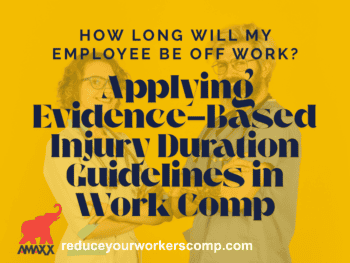
The RTW Ratio is simple to calculate but incredibly powerful. It provides real-time insight into how well an organization is helping injured employees get back to work safely and quickly. And more importantly, it predicts future claims costs, experience modification factors (mods), and employee outcomes better than almost any other metric.
Click Link to Access Free PDF Download
“13 Research Studies to Prove Value of Return-to-Work Program & Gain Stakeholder Buy-In”
In this post, we’ll explore what the Return-to-Work Ratio is, why it’s so important, and how you can use it to drive better results across your workers’ comp program.
What Is the Return-to-Work Ratio?
The Return-to-Work Ratio measures the percentage of injured employees who return to work within 0–4 days of the injury. It’s a direct indicator of how effective your RTW and transitional duty programs are.
Here’s how it works:
| Employee | Injury Date | Return to Work Date | Days Out |
|---|---|---|---|
| Jane Smith | 3/20 | 3/20 | 0 |
| Tom Anderson | 2/20 | 2/28 | 8 |
| Bill Jacobs | 2/15 | 3/10 | 23 |
In the example above, only one out of three employees returned to work within 4 days, which equals a RTW Ratio of 33%.
A strong return-to-work program should achieve 90%+ in this 0–4 day category. Best-in-class organizations aim for 95% or higher.
Why Is 0–4 Days So Critical?
Most states have a waiting period (commonly 3–7 days) before indemnity benefits are paid. If an employee returns to work within that period, no lost wage benefits are paid—keeping the claim medical-only.
Here’s why that matters:
-
No indemnity payments = dramatically lower claim costs
-
No lost time = claim is not classified as a lost-time claim
-
Lower cost = improved experience mod and insurance premiums
It’s not just about dollars. When workers return quickly—even in modified roles—they stay connected to their routine, avoid psychosocial complications like depression, and recover faster.
The RTW Ratio as a Leading Indicator
Most workers’ comp metrics are backward-looking. You can’t act on them until the damage is already done. The RTW Ratio flips the script by providing real-time feedback on how well your process is working today.
Here’s what a high RTW Ratio tells you:
-
You’re working effectively with your medical providers
-
You’re obtaining work restrictions quickly
-
You have meaningful transitional duty jobs available
-
Your supervisors are engaging with the process
-
Your claims team is proactive and coordinated
If your RTW Ratio is below 90%, there’s room for improvement—and every percentage point counts.
Visualizing the Data: A Tale of Two Companies
Let’s compare two companies based on their return-to-work performance.
Company A – Strong RTW Program
-
1–4 Days: 93%
-
5–10 Days: 4%
-
11–20 Days: 2%
-
21+ Days: 1%
Company B – Weak RTW Program
-
1–4 Days: 48%
-
5–10 Days: 22%
-
11–20 Days: 17%
-
21+ Days: 13%
Company A keeps most injuries in the 0–4 day window, avoiding lost-time claims and reducing costs. Company B, on the other hand, faces more lost time, higher indemnity costs, and a higher experience mod—leading to increased insurance premiums.
Cost Impact of Poor RTW Performance
According to the RIMS Benchmark Survey, companies with fewer than 50% of injured workers returning within 4 days are 2.5 times more likely to have a mod above 1.1.
A high mod drives up insurance premiums—and those costs stay elevated for years.
Let’s break it down:
-
One avoidable lost-time claim might cost $10,000
-
That claim stays on your mod for three years
-
A mod increase of just 0.1 can mean tens of thousands in premium hikes
Multiply that across several claims, and it’s easy to see how poor RTW performance can become a financial anchor.
How to Improve Your RTW Ratio
1. Track It Consistently
Start by calculating your RTW Ratio monthly or quarterly. Use categories like:
-
0–4 days
-
5–10 days
-
11–20 days
-
21–50 days
-
51–120 days
-
120+ days
Graph it over time. Compare locations, departments, or supervisors.
2. Build a Transitional Duty Job Bank
Have a library of light-duty or modified assignments ready in advance. Include wish-list tasks from each department that can be completed under restrictions.
3. Communicate with Medical Providers
Let doctors know your company can accommodate restrictions. Share job descriptions or transitional task options proactively.
4. Create a Culture That Supports RTW
Educate employees on the value of transitional duty. Position it as a way to stay engaged—not a punishment or demotion.
5. Coordinate with Your Claims Team
Ensure your third-party administrator (TPA) or claims adjusters prioritize early return-to-work and communicate with treating physicians about your capabilities.
FREE DOWNLOAD: “13 Research Studies to Prove Value of Return-to-Work Program & Gain Stakeholder Buy-In”
Conclusion: Don’t Ignore the Ratio That Predicts Everything
The Return-to-Work Ratio may be the most underused, high-impact metric in workers’ comp. It’s easy to calculate, easy to track, and powerful enough to drive meaningful change in both costs and outcomes.
If you’re not currently tracking your RTW Ratio, now is the time to start. Because the faster you get employees back to work, the faster your workers’ comp program becomes a driver of savings—not a source of stress.
 Michael Stack, CEO of Amaxx LLC, is an expert in workers’ compensation cost containment systems and provides education, training, and consulting to help employers reduce their workers’ compensation costs by 20% to 50%. He is co-author of the #1 selling comprehensive training guide “Your Ultimate Guide to Mastering Workers’ Comp Costs: Reduce Costs 20% to 50%.” Stack is the creator of Injury Management Results (IMR) software and founder of Amaxx Workers’ Comp Training Center. WC Mastery Training teaching injury management best practices such as return to work, communication, claims best practices, medical management, and working with vendors. IMR software simplifies the implementation of these best practices for employers and ties results to a Critical Metrics Dashboard.
Michael Stack, CEO of Amaxx LLC, is an expert in workers’ compensation cost containment systems and provides education, training, and consulting to help employers reduce their workers’ compensation costs by 20% to 50%. He is co-author of the #1 selling comprehensive training guide “Your Ultimate Guide to Mastering Workers’ Comp Costs: Reduce Costs 20% to 50%.” Stack is the creator of Injury Management Results (IMR) software and founder of Amaxx Workers’ Comp Training Center. WC Mastery Training teaching injury management best practices such as return to work, communication, claims best practices, medical management, and working with vendors. IMR software simplifies the implementation of these best practices for employers and ties results to a Critical Metrics Dashboard.
Contact: [email protected].
Workers’ Comp Roundup Blog: https://blog.reduceyourworkerscomp.com/
Injury Management Results (IMR) Software: https://imrsoftware.com/
©2025 Amaxx LLC. All rights reserved under International Copyright Law.
Do not use this information without independent verification. All state laws vary. You should consult with your insurance broker, attorney, or qualified professional.
















